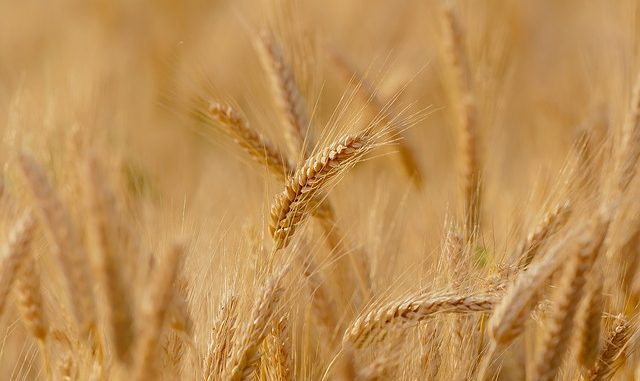
In the last few years there has been considerable interest in bioactive peptides sourced from natural products. Soy and cereals are noted for their treasure trove of interesting bioactive peptides and we review one in particular called lunasin which is found in these plants. Lunasin is well reviewed by a number of authors -just read Hernandez-Ledesma et al (2009) for a comprehensive analysis.
Cereal Derived Lunasin
Wheat is a strong source of lunsain. It is extracted from the kernel (Jeong et al., 2007a; Nakuerte et al., 2012) and can withstand basic processing where it is retained in whole wheat flour and its dough (Rizello et al., 2012). Other cereals containing the peptide are rye (Jeong et al., 2009), triticale (Nakuerte et al., 2012) and barley (Jeong et al., 2002).
Soya Derived Lunasin
Soy isoflavones are potent nutritional compounds for supplementation but the soya bean also throws up this very interesting cancer-preventative peptide -lunasin.
We’ve always had a strong regard for soy based products be they for protecting men against prostate cancer for example as well as decreasing the risk of breast and endometrial cancers. In fact, consuming soy milk daily was associated in one study with a 70% reduction in prostate cancer when compared to those not taking it (Hebert et al., 1998).
One of the peptides that is responsible for these benefits is lunasin, for the many and varied health benefits. It has a range of actions or antagonisms against a number of potent chemical carcinogens which have been demonstrated in mammalian cells and a mouse model for skin cancer. When orally ingested, studies in rats and mice studies, it shows good bioavailability meaning that dietary supplementation is possible. It is taken up by mammalian cells relatively rapidly usually within minutes of exogenous application and remains within the nucleus for up to 18 hours.
It is a 4.8 kDa peptide of 43 amino acids and contains 8 aspartic acid residues in its carboxyl end preceded by a cell-adhesion motif Arg-Gly-Asp(RGD).
Its biochemical action is to inhibit the acetylation of the core histones (Galvez et al., 2001). This causes cell death especially in rapidly dividing cells by upsetting the events that lead to DNA replication and cell division.
Lunasin is not just available in soy products, it is found in barley (Jeong et al., 2002) wheat (Jeong et al., 2007) and aubergines (Solanum nigrum L.).
The point of this article is to expand the post so as to encompass as much about the peptide as possible. I will return to it as more information appears about its benefits.
References
Akiyama, S. K.; Olden, K; Yamada, K. M. (1986) Fibronectin and integrins in invasion and metastasis. Cancer Metastasis ReV. 14, pp. 173–189.
Ben, O. (2005). Lunasin: a cancer-preventive soy peptide. Nutrition reviews, 63(1), pp. 16-21.
Galvez, A. F., Chen, N., Macasieb, J., & Ben, O. (2001). Chemopreventive property of a soybean peptide (lunasin) that binds to deacetylated histones and inhibits acetylation. Cancer Research, 61(20), pp. 7473-7478
Hebert, J.R., Hurley, T.G., Olendzki, B.C., Teas, J., Ma, Y., Hampl, J.S. (1998) Nutritional and socioeconomic factors in relation to prostate cancer mortality: a cross-national study. J. Natl. Cancer Inst. 90 pp. 1637-1647.
Hernandez-Ledesma, B., Hsieh, C. C., & Ben, O. (2009). Lunasin, a novel seed peptide for cancer prevention. Peptides, 30(2), pp. 426-430
J, , , & (2007a). Inhibition of core histone acetylation by the cancer preventive peptide lunasin. Journal of Agricultural and Food Chemistry, 55, pp. 632–637. (Article)
Jeong, H. J., Lam, Y., de Lumen, B. O. (2002) Barley lunasin suppresses ras-induced colony formation and histone acetylation in mammalian cells. J. Agric. Food. Chem. 50,pp. 5903–5908
, , , , , & (2009). The cancer preventive seed peptide lunasin from rye is bioavailable and bioactive. Nutrition and Cancer, 61, pp. 680–686. https://doi.org/10.1080/01635580902850082.
Jeong, H. J.; Jeong, J. B.; Kim, D. S.; Park, J. H.; Lee, J. B.; Kweon, D. H.; Chung, G. Y.; Seo, E. W.; de Lumen, B. O. (2007) The cancer preventive peptide lunasin from wheat inhibits core histone acetylation. Cancer Lett. 255, pp. 42–48.
, , , , , , … (2012). Discovery of lunasin peptide in triticale (X Triticosecale Wittmack). Journal of Cereal Science, 56, pp. 510–514. https://doi.org/10.1016/j.jcs.2012.04.004.
R, , , & (2012). Synthesis of the cancer preventive peptide lunasin by lactic acid bacteria during sourdough fermentation. Nutrition and Cancer, 64, pp. 111–120. https://doi.org/10.1080/01635581.2012.630159. .
Ruoslahti, E.; Pierschbacher, M. D. (1986) Arg-Gly-Asp: A versatile cell recognition signal. Cell 44, pp. 517–518.


Leave a Reply